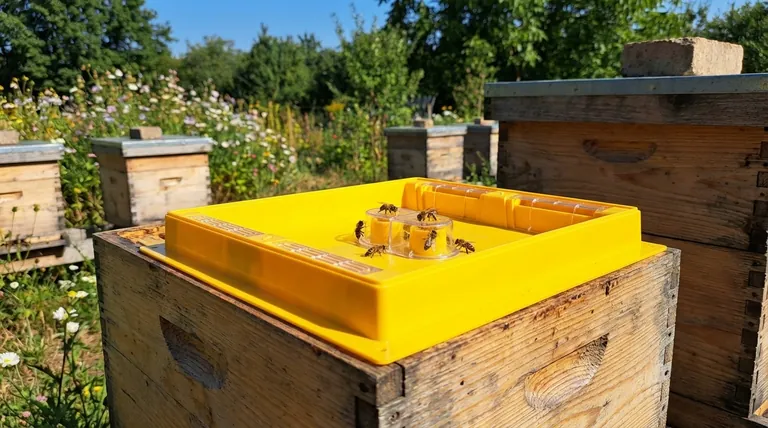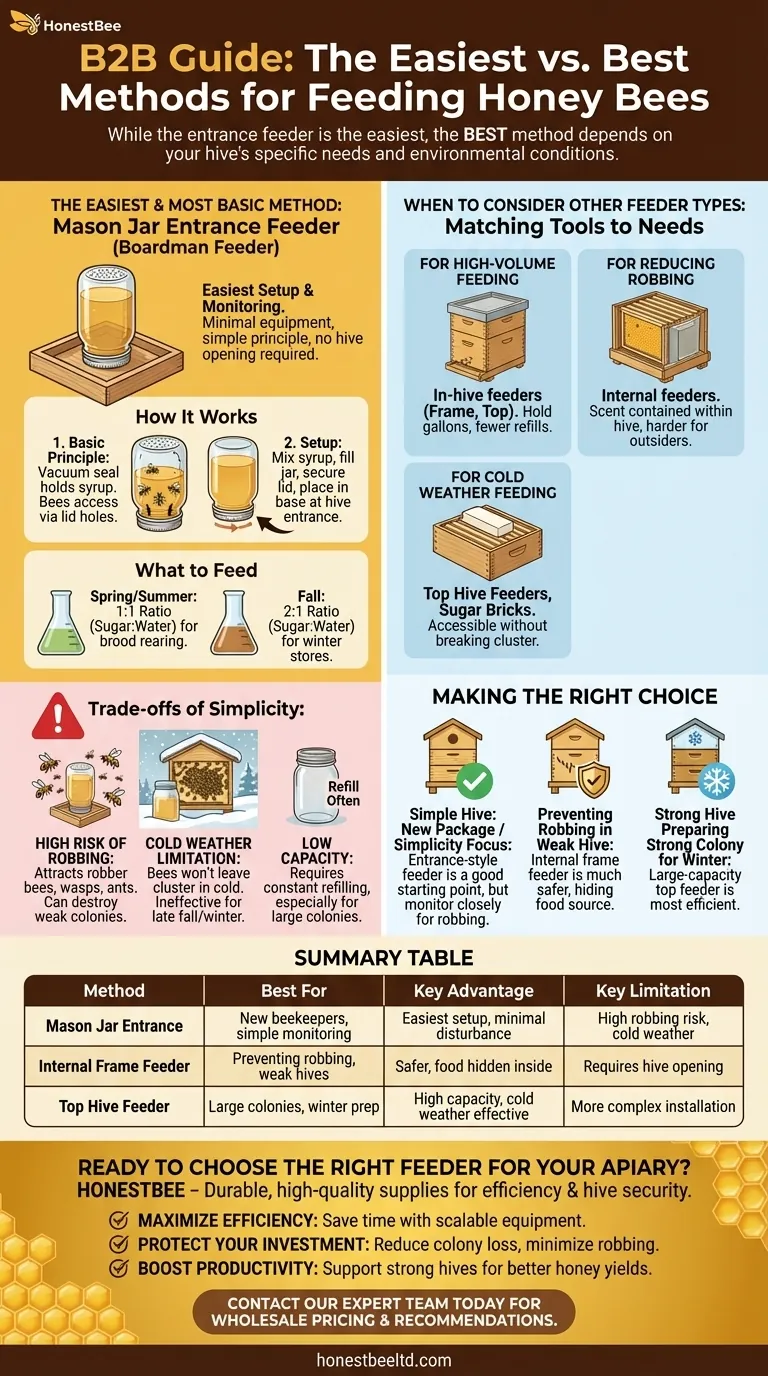The easiest and most basic method for feeding honey bees is using an entrance-style mason jar feeder, often called a Boardman feeder. This method involves filling a standard mason jar with sugar syrup, attaching a perforated lid, and placing it inverted into a small wooden or plastic tray that slides into the hive's entrance. Its simplicity makes it a very common choice for new beekeepers.
While the mason jar entrance feeder is undeniably the easiest to set up and monitor, its convenience comes with significant trade-offs. The best feeding method is not just about ease of use, but about matching the right tool to your hive's specific needs and the current environmental conditions.

How a Mason Jar Feeder Works
The mason jar feeder is a classic for a reason. It operates on a simple principle and requires minimal equipment, most of which you may already have.
The Basic Principle
The feeder works by creating a vacuum seal. Once you fill the jar with syrup and invert it, the liquid is held in place by air pressure. Bees can then access the syrup through the small holes in the lid without the contents draining out all at once.
Setting It Up
Setup is straightforward. You simply mix your sugar syrup, fill the jar, and tightly screw on the special perforated lid. The feeder base is placed at the entrance of the hive, and the inverted jar is set into the designated circular slot.
What to Feed
The syrup recipe depends on the season and your goal. A 1:1 ratio of sugar to water is used for spring and summer feeding to stimulate brood rearing. A thicker 2:1 ratio of sugar to water is used in the fall to help bees build up their winter food stores.
Understanding the Trade-offs of Simplicity
The easiest method is not always the most effective or the safest for your bees. Understanding the pros and cons is essential for responsible hive management.
The Primary Benefit: Accessibility
The key advantage is ease of use. You can see the syrup level at a glance from a distance and refill the jar without opening the hive. This minimizes disturbance to the colony, which is especially beneficial for new or small hives.
The Major Drawback: Robbing
Placing a food source at the entrance is like putting up a "free food" sign for robber bees from other colonies, wasps, and ants. A robbing frenzy can quickly overwhelm and destroy a weak colony. The scent of the syrup is an open invitation to unwanted guests.
Limitation: Temperature Sensitivity
Entrance feeders are not effective in cold weather. Bees form a tight cluster to stay warm and will not break that cluster to travel to the cold entrance for food. This makes entrance feeders a poor choice for late fall or winter feeding.
Limitation: Capacity
A standard mason jar holds a relatively small amount of syrup. For a large, rapidly growing colony or for building winter stores, you will find yourself refilling the jar constantly, sometimes daily, which can negate its initial convenience.
When to Consider Other Feeder Types
As you gain experience, you will find that different situations call for different tools. Other feeders solve the specific problems that entrance feeders create.
For High-Volume Feeding
When you need to deliver a large amount of syrup quickly, in-hive feeders are superior. Frame feeders and top feeders can hold a gallon or more, allowing you to feed a colony for many days with a single fill.
For Reducing Robbing
The best way to prevent robbing is to move the food source inside. Internal frame feeders or top feeders keep the syrup's scent contained within the hive, making it much harder for outsiders to detect.
For Cold Weather Feeding
In colder temperatures, food must be placed directly above the bee cluster. Top hive feeders, moisture quilts with sugar bricks, or candy boards ensure the bees can access nourishment without having to leave the life-saving warmth of their huddle.
Making the Right Choice for Your Goal
Ultimately, the feeder you choose should be a conscious decision based on your specific objective.
- If your primary focus is simplicity and monitoring a new package: The entrance-style mason jar feeder is an excellent starting point, but watch carefully for signs of robbing.
- If your primary focus is preventing robbing in a weak hive: An internal frame feeder is a much safer choice, as it contains the food source entirely within the hive.
- If your primary focus is preparing a strong colony for winter: A large-capacity top feeder will be the most efficient and effective option for delivering the necessary volume of syrup.
Choosing the correct feeder is a simple but powerful way to support the health and security of your hive.
Summary Table:
| Feeding Method | Best For | Key Advantage | Key Limitation |
|---|---|---|---|
| Mason Jar Entrance Feeder | New beekeepers, simple monitoring | Easiest setup and refill, minimal hive disturbance | High risk of robbing from other bees and pests |
| Internal Frame Feeder | Preventing robbing, weak hives | Food source is hidden inside the hive, safer | Requires opening the hive to check and refill |
| Top Hive Feeder | Large colonies, winter preparation | High capacity, effective in cold weather | More complex installation |
Ready to choose the right feeder for your apiary?
Whether you're a commercial beekeeper managing hundreds of hives or a distributor supplying equipment to others, the right feeding solution is critical for colony health and honey production. HONESTBEE supplies durable, high-quality beekeeping supplies and equipment, including a range of feeders designed for efficiency and hive security.
We help you:
- Maximize Efficiency: Save time with equipment built for scale and durability.
- Protect Your Investment: Reduce colony loss with feeders that minimize robbing.
- Boost Productivity: Support strong, healthy hives for better honey yields.
Let's discuss the best feeding solutions for your operation. Contact our expert team today for wholesale pricing and recommendations tailored to your needs.
Visual Guide

Related Products
- Professional Hive Top Bee Feeder for Beekeeping
- HONESTBEE Entrance Bee Feeder Professional Hive Nutrition Solution for Beekeeping
- HONESTBEE Professional Hive Top Bee Feeder Feeding Solution
- Boardman Entrance Bee Feeder Durable Galvanized Steel and Wood Construction for Beekeeping
- In-Hive Dual Compartment Frame Bee Feeder for Targeted Colony Nutrition
People Also Ask
- Why is a top feeder essential for bees? Ensure Colony Health and Efficiency
- What is the best bee feeder for a hive? Choose the Right Feeder for Your Apiary's Scale
- How to use a top feeder in a beehive? A Guide to Effective Beehive Feeding
- What are the features of top feeders for bees? Maximize Hive Health with Safe, High-Capacity Feeding
- What types of hive boxes is the round hive top feeder compatible with? Universal Fit for 8 & 10-Frame Langstroth Hives



















